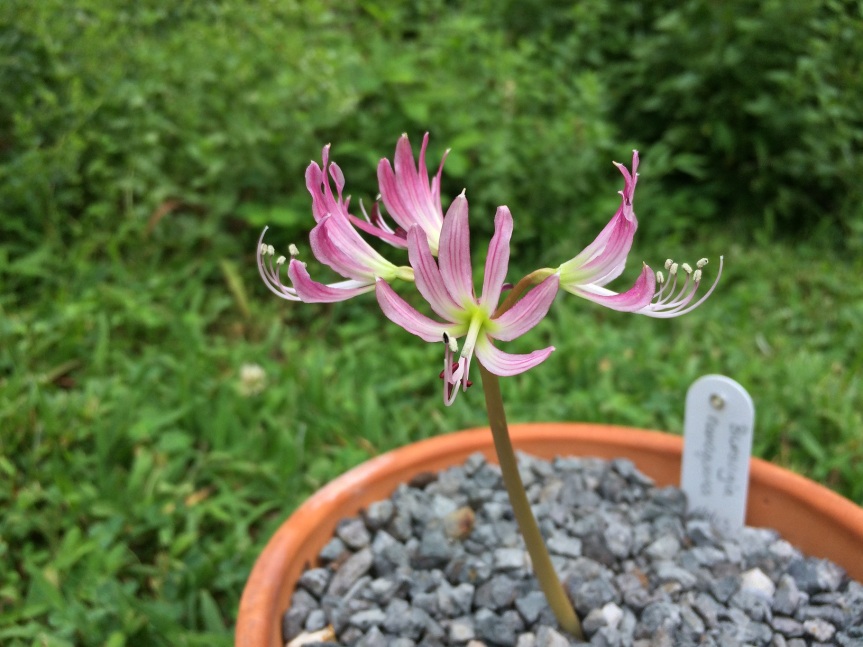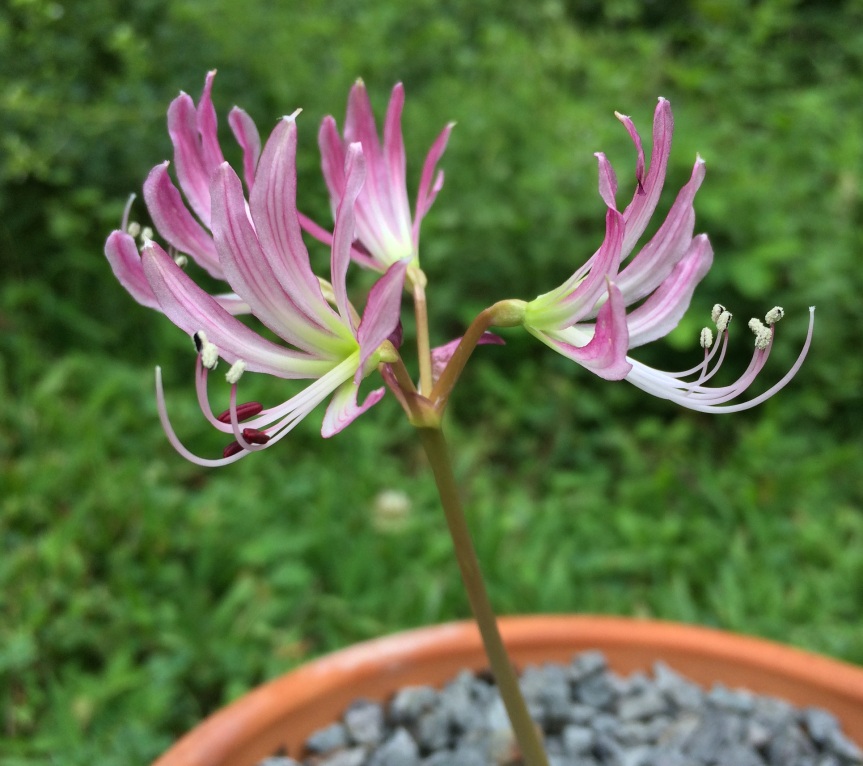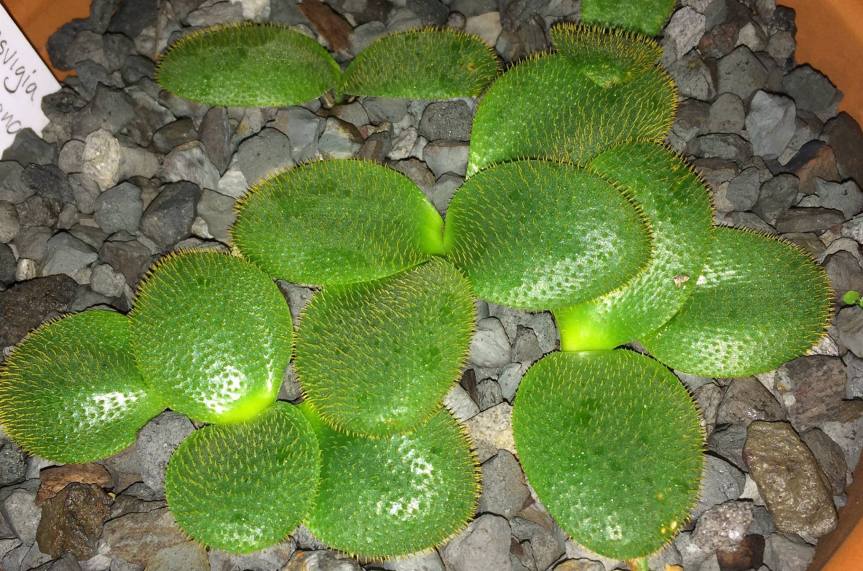
If you aren’t a plant geek, these little flowers probably don’t seem very exciting. They’re small, not very brightly colored, and sort of an odd shape. But I was surprised and delighted to see them in my greenhouse this week, the first flowers produced by half a dozen Brunsvigia namaquana bulbs that I have been growing since 2013. For those of you who aren’t obsessed with amaryllids, I’ll try to explain why I was so thrilled.

The genus Brunsvigia is, as I indicated above, part of the Amaryllidaceae, the amaryllis family. There are seventeen Brunsvigia species, all growing as deciduous bulbs and all from southern Africa. The largest species like B. josephinae have 50-60-cm diameter umbels of deep red flowers on stout stems that can support the sunbirds that pollinate them. B. namaquana, at the opposite end of the scale, is the smallest species, with leaves about 4 cm long growing from a bulb only 2-3 cm in diameter. The inflorescence is about 10 cm tall.
If you are interested in bulbs or succulent plants, the species epithet “namaquana” is highly evocative. It refers to Namaqualand, an arid region in northwestern South Africa and southern Namibia that is famous for its flora. The most spectacular endemic plant species is the Halfmens, Pachypodium namaquanum, but per Wikipedia, almost one third of the plants that grow in Namaqualand are found nowhere else.
Like most Namaqualand plants, B. namaquana is a winter grower, producing its foliage after autumn rains and going dormant in spring. The prostrate leaves of B. namaquana have odd yellowish bristles on their upper surfaces and are almost more interesting than the flowers.

My plants should be deep in their summer dormancy, so I was very surprised to see these flowers. The pot containing the bulbs, along with the pots of various other winter growers, was shoved into the back corner of the greenhouse where they can stay warm and dry, and where I am unlikely to accidentally water them. Ordinarily I don’t pay them much attention during the summer, but I happened to glance over at just the right time. I would have been annoyed if I had found the mummified remains of the inflorescence when I pull the pot out this autumn.
I would have expected the plants to flower–if they were going to flower–in early autumn, just before the leaves emerge. However, according to Graham Duncan [1], B. namaquana in its natural habitat flowers erratically any time from November to May (early summer to late autumn), usually in response to brief, sporadic rain showers. I am fairly sure I didn’t accidentally water the dormant bulbs, but the past several weeks have been very rainy. Possibly the consistently high humidity was enough to wake up one of the bulbs.
B. namaquana is not common in cultivation, at least not in the United States, but if you are lucky enough to obtain some bulbs, I’d suggest growing them in a well drained mix in an unglazed terracotta pot so that they dry rapidly after watering. I use a mix of roughly equal parts commercial potting soil, coarse silica sand, and stalite (permatill). In a plastic pot, I’d cut way back on the potting soil and use a mostly inorganic mix. I usually start watering in mid September and keep the pot outside during dry weather until the first frosts threaten. Then I bring the plants inside and continue watering weekly or biweekly depending on how sunny the weather is. The plants usually start to go dormant in late February or early March, and I leave the pot completely dry all summer. Humidity is fairly high in the greenhouse, though, and that probably helps to prevent too much desiccation of the bulbs. Minimum temperature in the greenhouse is 60 F (15.5C) in winter, and maximum temperature is 90 F (32 C) in summer.
It will be interesting to see if any more of the bulbs bloom this autumn.
Reference
- Duncan, G., Jeppe, B., and Voight, L. (2016) The Amaryllidaceae of Southern Africa, Umdaus Press, Pretoria, South Africa.

I find the leaves and blooms of Brunsvigia namaquana equally fascinating, and you’ve grown them beautifully. Well done!
LikeLiked by 2 people
Thanks, Charles. You ought to try some of the small amaryllids. They’re neat little miniatures.
LikeLike
Which ones are the tiniest?
LikeLike
Some Cyrtanthus are pretty small (e.g. C. brachyscyphus, C. macowanii). B. namaquana, of course. Strumaria species. In South America, there’s Eithea blumenavia and Griffinia liboniana.
Admittedly, most of these are dwarf, rather than virtually microscopic like your favorite pleurothallids. They’re roughly the same scale as Paph niveum–bloom in 3″ pots. There are some really tiny bulbs in other families. Check out Ornithogalum sardienii.
LikeLiked by 1 person
Thanks for the tips, Nick.
LikeLike
Congratulations. I have also grown them for years with very sporadic flowering. From seed they take nearly 10 years before they will flower.
LikeLiked by 1 person
I suppose my bulbs must have been several years old when I purchased them (from Steven Hammer). Ten years is a long time to wait. I’ve got some three and four year old seedlings of B. josephinae and B. grandiflora coming along. Hopefully I’ll see blooms in the next decade or two.
LikeLike
Hi Nick, I came to your site via the note to PBS on Brunsvigia, but ended up reading all your postings on gardening in North Carolina. Very thoughtful and interesting posts about the flowers you’ve got growing and the pests that you’ve had to overcome. Nice photography too!
LikeLiked by 2 people
Thanks, John. I appreciate it. I check in at your MacGardens blog fairly regularly and have added some plants to my wishlist as a result.
LikeLike